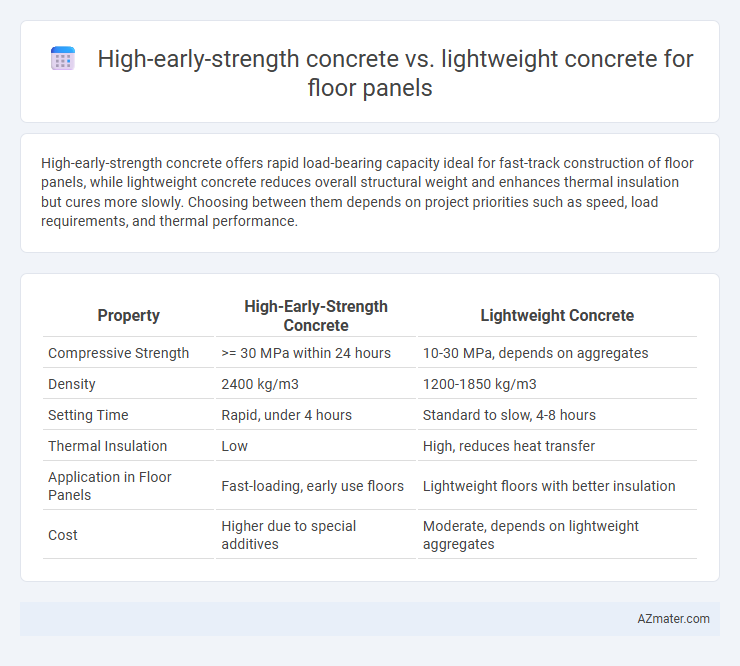High-early-strength concrete offers rapid load-bearing capacity ideal for fast-track construction of floor panels, while lightweight concrete reduces overall structural weight and enhances thermal insulation but cures more slowly. Choosing between them depends on project priorities such as speed, load requirements, and thermal performance.
Table of Comparison
| Property | High-Early-Strength Concrete | Lightweight Concrete |
|---|---|---|
| Compressive Strength | >= 30 MPa within 24 hours | 10-30 MPa, depends on aggregates |
| Density | 2400 kg/m3 | 1200-1850 kg/m3 |
| Setting Time | Rapid, under 4 hours | Standard to slow, 4-8 hours |
| Thermal Insulation | Low | High, reduces heat transfer |
| Application in Floor Panels | Fast-loading, early use floors | Lightweight floors with better insulation |
| Cost | Higher due to special additives | Moderate, depends on lightweight aggregates |
Introduction to High-Early-Strength and Lightweight Concrete
High-early-strength concrete achieves compressive strength faster than traditional concrete, often reaching 20-40 MPa within 24 hours, making it ideal for accelerating construction schedules. Lightweight concrete, characterized by its reduced density (typically 1440-1840 kg/m3), uses lightweight aggregates such as expanded clay or shale to decrease structural load while enhancing thermal insulation. Both materials serve distinct purposes in floor panel applications, balancing speed of strength gain and weight considerations to optimize structural performance.
Key Material Properties and Composition
High-early-strength concrete achieves rapid strength gain through a higher cement content and the use of supplementary cementitious materials like silica fume, offering compressive strengths exceeding 20 MPa within 24 hours, ideal for fast-track floor panel installations. Lightweight concrete incorporates lightweight aggregates such as expanded shale or pumice, reducing density to 800-1600 kg/m3 while maintaining adequate compressive strength between 10-30 MPa, which enhances thermal insulation and reduces dead load on floor structures. The material composition of high-early-strength concrete emphasizes rapid hydration reactions, whereas lightweight concrete balances strength and weight by optimizing aggregate porosity and cement matrix compatibility.
Strength and Load-Bearing Capacity
High-early-strength concrete exhibits superior compressive strength shortly after curing, enabling faster construction schedules and increased load-bearing capacity for floor panels. Lightweight concrete, while offering reduced dead loads and enhanced thermal insulation, typically demonstrates lower strength compared to high-early-strength variants, making it less suitable for applications demanding maximum structural performance. Selecting between the two depends on balancing the need for rapid strength gain and high load-bearing capacity against weight reduction and thermal benefits.
Weight and Structural Implications
High-early-strength concrete offers superior load-bearing capacity with faster curing times, making it ideal for floor panels requiring rapid construction schedules and high structural performance. Lightweight concrete significantly reduces the overall weight of floor panels, easing support requirements and improving seismic resistance but may have lower compressive strength compared to high-early-strength alternatives. Selecting between these materials depends on balancing weight reduction for structural efficiency against the necessity for high strength and durability in floor panel applications.
Setting Time and Construction Speed
High-early-strength concrete sets rapidly, often reaching initial set within 1 to 3 hours, enabling faster construction speed and quicker load application on floor panels. Lightweight concrete, with slower setting times typically ranging from 4 to 8 hours, provides benefits in reduced dead load but may delay overall project timelines due to extended curing periods. Optimizing setting time with high-early-strength concrete supports accelerated floor panel installation and early demolding, significantly enhancing construction efficiency.
Durability and Long-Term Performance
High-early-strength concrete offers superior durability and faster load-bearing capacity, making it ideal for floor panels needing quick installation and early use without compromising long-term structural integrity. Lightweight concrete enhances thermal insulation and reduces dead load, but may exhibit reduced abrasion resistance and slightly lower compressive strength compared to high-early-strength mixes, impacting long-term performance under heavy traffic. Optimizing mix design and incorporating supplementary cementitious materials can improve the durability and longevity of both concrete types in floor panel applications.
Thermal and Acoustic Insulation Comparison
High-early-strength concrete exhibits superior load-bearing capacity and rapid curing, but lightweight concrete provides enhanced thermal insulation with lower thermal conductivity values, typically between 0.1 to 0.3 W/m*K. Lightweight concrete's porous structure also offers better acoustic insulation, reducing sound transmission by 40-60% compared to the denser high-early-strength concrete. For floor panels requiring efficient energy conservation and noise reduction, lightweight concrete is the preferred choice despite the slightly lower structural strength.
Cost Analysis and Economic Considerations
High-early-strength concrete offers faster construction schedules and early load-bearing capacity, which can reduce labor and formwork costs, making it economically viable for time-sensitive projects. Lightweight concrete, while generally more expensive per cubic meter due to specialized aggregates and additives, can lower overall structural costs by reducing dead loads and foundation requirements. Cost analysis must weigh initial material expenses against long-term savings from structural efficiency and project timelines to determine the optimal choice for floor panels.
Suitability for Different Floor Panel Applications
High-early-strength concrete offers rapid strength gain, making it ideal for floor panels requiring quick turnaround times such as commercial and industrial projects with tight schedules. Lightweight concrete provides superior thermal insulation and reduced load on supporting structures, making it suitable for residential buildings and areas requiring enhanced energy efficiency. Choosing between these concretes depends on project priorities like speed of construction versus thermal performance and structural load considerations.
Environmental Impact and Sustainability
High-early-strength concrete for floor panels offers rapid load-bearing capacity but typically involves higher cement content, leading to increased CO2 emissions and environmental impact. Lightweight concrete reduces structural dead load and enhances thermal insulation, promoting energy efficiency and sustainability by incorporating recycled materials like fly ash or expanded aggregates. The choice between these concretes influences the carbon footprint and resource consumption of construction projects, with lightweight concrete generally supporting greener building practices.

Infographic: High-early-strength concrete vs Lightweight concrete for Floor panel
 azmater.com
azmater.com